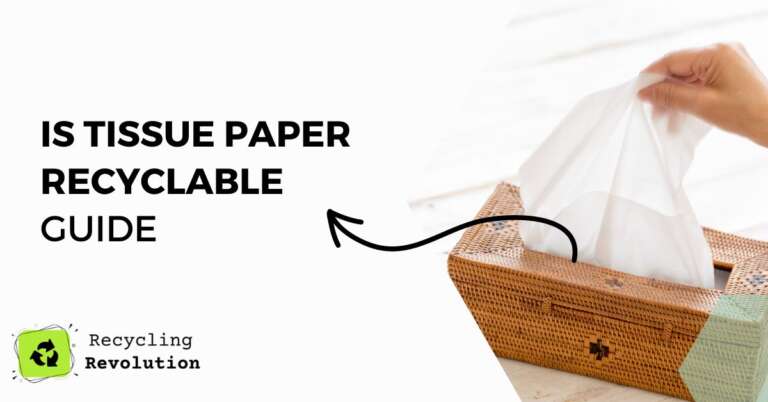Tissue paper is a product that needs to be recycled, but It can’t be thrown away with your other trash.
The paper, often used for wrapping gifts and as party decorations, is too delicate for regular recycling.
Tissue paper can’t be recycled in curbside bins or at recycling drop-off centres because it’s considered a wet paper product.
What is Tissue Paper Made From?
Tissue paper is a thin, lightweight paper most commonly used for wrapping delicate items or creating papier-mâché.
It is also frequently used as a packing material or filler in gift bags.
While tissue paper is not as strong as cardboard, it is much more pliable and can be easily torn by hand.
Tissue paper is made from wood pulp and is typically bleached to create a white colour.
The wood pulp fibres are beaten and then pressed together to form a sheet of paper.
The tissue paper manufacturing process often uses fewer chemicals than other types of paper production, making it a relatively eco-friendly option.
While tissue paper is recyclable, it is often not accepted by curbside recycling programs due to its lightweight and tendency to clog machines.
However, many office buildings and malls have special collection bins for tissue paper recycling.
You can also check with your local waste management facility to see if they accept tissue paper for recycling.
Types of Tissue Paper
Tissue paper is often used for wrapping delicate items, such as clothing, crafts, such as making paper flowers.
There are two main types of tissue paper: bleached and unbleached. Bleached tissue paper has undergone a chemical treatment process to make it white.
This type of tissue paper is usually found in gift wrap or packaging that needs to look clean and crisp. Unfortunately, the chemicals used to bleach tissue paper are harmful to the environment.
Unbleached tissue paper has a natural brown colour and this type of tissue paper is usually found in brown grocery bags or wrapping paper.
It is easier to recycle than bleached tissue paper because it contains no harmful chemicals.
Where to Recycle Tissue Paper
The good news is that tissue paper may be composted at home and is accepted at many commercial composting sites as long as it doesn’t include foil or glitter.
Because it absorbs excess moisture produced by food waste and bioplastics, plain tissue paper can be beneficial to a compost pile.
How to Recycle Tissue Paper
Tissue paper can be recycled, but it must be clean and dry.
To recycle tissue paper, follow these steps:
- Collect used tissue paper in a bag or container.
- Rinse used tissue paper under cool water.
- Remove any food or makeup stains with a mild soap.
- Allow the tissue paper to air dry ultimately.
- Place the dry tissue paper in a recycling bin or bag.
Creative Ways To Reuse Tissue paper.
Here are creative ways to reuse tissue paper:
Party Decorations
Tissue paper makes beautiful decorations for any occasion.
You can use them to decorate tables or hang them from the ceiling like flags.
Tissue paper can also be used as confetti at weddings and birthdays.
Advent Calendar
Decorate an advent calendar with tissue paper to count the days until Christmas! This would be a fun activity for kids during the holiday season.
Use It As A Nightlight Shade
If you have an old lamp with a cracked shade or want to change the look of your favourite lampshade, try covering it with tissue paper instead of replacing it with another one.
For example, if you have an old school desk lamp, you can protect its shade with different colours of tissue paper to give it a new look.
Just be careful not to tear or rip the tissue paper while doing so because this will ruin its original purpose.
If you don’t like how your first attempt went, then try again until you get a result that makes you happy!
Picture Frames
Use tissue paper to frame pictures! Just cut out an image from a magazine or print one off your computer and glue it onto construction paper.
Then cover it with tissue paper and trim around the edges, so they’re even.
Add some ribbon and hang it up!
Use as packing material.
Tissue paper can be used as packing material for fragile items during shipping or moving.
The soft texture will protect your valuables from being damaged during transit, and the colourful design will make your package stand out among other brown boxes.
Frequently Asked Questions
Can I flush tissue paper?
The thinness and texture of tissue paper may give the impression that it may be flushed. Tissue paper shouldn’t, however, be flushed.
Tissue paper does not degrade when it gets wet, in contrast to toilet tissue. There shouldn’t be any issues with flushing a single tissue paper.
However, flushing tissue paper might eventually result in more serious issues if you do so frequently. It won’t decompose when wet, so that it might clog your septic system or pipes.
It is better to avoid flushing tissue paper because this might be a costly remedy.
How Do You Dispose of Tissue Paper Correctly?
Tissue paper should be placed in your recycling bin as other paper products (like newspapers and magazines). It should not be thrown away in your trash because it takes up valuable space in landfills and takes too long to break down naturally.
How Long Does Tissue Paper Take To Decompose?
Tissue paper is biodegradable, which means it will break down over time. However, it can take years for tissue paper to decompose completely and become part of the soil. Factors that affect the rate at which tissue paper breaks down include the type of tissue paper and its thickness.
The thicker the tissue paper is, the longer it will take to decompose.
Conclusion
We hope our tips on recycling tissue paper have been helpful! Whether you recycle your own tissue paper at home or donate it to a local recycling centre, check with your local regulations to ensure you are disposing of it properly.
With a little effort, we can all help reduce our environmental footprint and make a difference for the planet.

